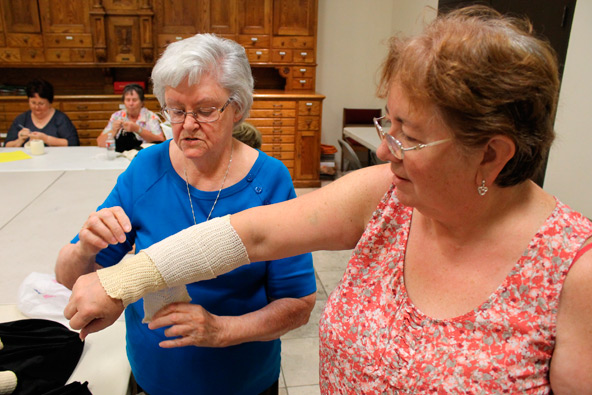
The chatter echoed down the hall from where a dozen ladies sat clustered around a large table, knitting and crocheting. This was no ordinary sewing circle. The group, dubbed “St. Damien’s Helpers,” crafts bandages for victims of Hansen’s disease, better known as leprosy.
The women, who belong to St. Joan of Arc Parish, began meeting last February after Margaret Hooks heard a homily on Jesus curing 10 lepers. Not long after that, a friend of Hooks showed her the bandages she was making for leprosy sufferers.
“She had pictures of them,” Hooks said. “It would break your heart.” The woman told Hooks that the bandages were shipped to Washington State and from there, to developing countries where leprosy is still common and disposable bandages are not used. The advantage of the handmade bandages is that they can be laundered, sterilized and reused.
“I went home and I prayed and I said, ‘Lord, if this is what You want me to do, then give me a sign.’” Hooks, who is a third order Dominican, received a sign shortly thereafter when a complete stranger approached her and related that her mother had died from leprosy.
Since she was new to the parish, Hooks wasn’t sure who would help her with the undertaking. “You’ll have to bring the people, Jesus,” she prayed, “because I don’t know them.”
Hooks’ prayers were answered. During the busy winter months, the group mushroomed to 50 members, especially after Fr. Don Kline, pastor of St. Joan of Arc, preached about St. Damien, “Apostle to the Lepers” at weekday and Sunday Masses.
Deb Jones, who manages stewardship and the gift shop at the parish, has been working alongside the group as well.
“The crotchet and knitting helps with durability,” Jones said. “The bandages can be used over and over again. Some of these people are walking on stumps.”
So far, St. Damien’s Helpers have knitted or crocheted 100 bandages. It’s painstaking, monotonous work. The needles are tiny, the yarn colorless. Bandages have to be 48 inches long and four inches wide. After a while, the women admit their hands begin to cramp.
Sharon Brooks, a retired R.N., sat with her daughter working on her custom-made bandage. “I have arthritis in my hands, so I have to go slow,” Brooks said as she carefully worked the yarn.
The group is planning a boutique in November to raise money to buy more supplies. Pointing to the dwindling pile of white yarn, Hooks noted, “Once this is gone, it’s gone.”
St. Damien of Molokai was a Dutch priest who was canonized by Benedict XVI in 2009. His feast day is May 10, the day he stepped foot on the island of Molokai in Hawaii, to care for the lepers who had been quarantined there. He eventually contracted the disease himself and has been termed a “martyr of charity” for his selfless dedication in caring for lepers.
Leprosy is a treatable disease, but in many developing countries, sufferers do not have access to medicine.





